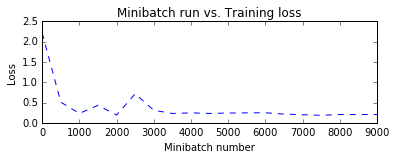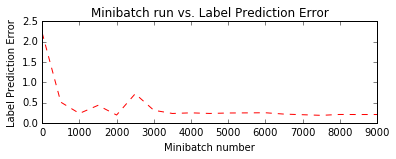In [1]:
from IPython.display import Image
CNTK 103: Part B - Logistic Regression with MNIST¶
We assume that you have successfully completed CNTK 103 Part A.
In this tutorial we will build and train a Multinomial Logistic Regression model using the MNIST data. This notebook provides the recipe using Python APIs. If you are looking for this example in BrainScript, please look here
Introduction¶
Problem: Optical Character Recognition (OCR) is a hot area research and there is a great demand for automation. The MNIST data comprises of hand-written digits with little background noise making it a nice dataset to create, experiment and learn deep learning models with reasonably small computing resources.
In [2]:
# Figure 1
Image(url= "http://3.bp.blogspot.com/_UpN7DfJA0j4/TJtUBWPk0SI/AAAAAAAAABY/oWPMtmqJn3k/s1600/mnist_originals.png", width=200, height=200)
Out[2]:

Goal: Our goal is to train a classifier that will identify the digits in the MNIST dataset.
Approach: The same 5 stages we have used in the previous tutorial are applicable: Data reading, Data preprocessing, Creating a model, Learning the model parameters and Evaluating (a.k.a. testing/prediction) the model. - Data reading: We will use the CNTK Text reader - Data preprocessing: Covered in part A (suggested extension section).
Rest of the steps are kept identical to CNTK 102.
Logistic Regression¶

In Binary Logistic Regression (see top of figure above), the input features are each scaled by an associated weight and summed together. The sum is passed through a squashing (aka activation) function and generates an output in [0,1]. This output value (which can be thought of as a probability) is then compared with a threshold (such as 0.5) to produce a binary label (0 or 1). This technique supports only classification problems with two output classes, hence the name binary LR. In the binary LR example shown above, the sigmoid function is used as the squashing function.
In Multinomial Linear Regression (see bottom of figure above), 2 or more output nodes are used, one for each output class to be predicted. Each summation node uses its own set of weights to scale the input features and sum them together. Instead of passing the summed output of the weighted input features through a sigmoid squashing function, the output is often passed through a softmax function (which in addition to squashing, like the sigmoid, the softmax normalizes each nodes’ output value using the sum of all unnormalized nodes). (Details in the context of MNIST image to follow)
In this tutorials, we will use multinomial LR for classifying the MNIST digits (0-9) using 10 output nodes (1 for each of our output classes).
In [3]:
# Import the relevant components
from __future__ import print_function # Use a function definition from future version (say 3.x from 2.7 interpreter)
import matplotlib.image as mpimg
import matplotlib.pyplot as plt
import numpy as np
import sys
import os
import cntk as C
import cntk.tests.test_utils
cntk.tests.test_utils.set_device_from_pytest_env() # (only needed for our build system)
C.cntk_py.set_fixed_random_seed(1) # fix the random seed so that LR examples are repeatable
%matplotlib inline
Initialization¶
In [5]:
# Define the data dimensions
input_dim = 784
num_output_classes = 10
Data reading¶
In this tutorial we are using the MNIST data you have downloaded using
CNTK_103A_MNIST_DataLoader notebook. The dataset has 60,000 training
images and 10,000 test images with each image being 28 x 28 pixels. Thus
the number of features is equal to 784 (= 28 x 28 pixels), 1 per pixel.
The variable num_output_classes is set to 10 corresponding to the
number of digits (0-9) in the dataset.
The data is in the following format:
|labels 0 0 0 1 0 0 0 0 0 0 |features 0 0 0 0 ...
(784 integers each representing a pixel)
In this tutorial we are going to use the image pixels corresponding the
integer stream named “features”. We define a create_reader function
to read the training and test data using the CTF
deserializer.
The labels are 1-hot
encoded. Refer to CNTK 103A
tutorial for data format visualizations.
In [6]:
# Read a CTF formatted text (as mentioned above) using the CTF deserializer from a file
def create_reader(path, is_training, input_dim, num_label_classes):
labelStream = C.io.StreamDef(field='labels', shape=num_label_classes, is_sparse=False)
featureStream = C.io.StreamDef(field='features', shape=input_dim, is_sparse=False)
deserailizer = C.io.CTFDeserializer(path, C.io.StreamDefs(labels = labelStream, features = featureStream))
return C.io.MinibatchSource(deserailizer,
randomize = is_training, max_sweeps = C.io.INFINITELY_REPEAT if is_training else 1)
In [7]:
# Ensure the training and test data is generated and available for this tutorial.
# We search in two locations in the toolkit for the cached MNIST data set.
data_found = False
for data_dir in [os.path.join("..", "Examples", "Image", "DataSets", "MNIST"),
os.path.join("data", "MNIST")]:
train_file = os.path.join(data_dir, "Train-28x28_cntk_text.txt")
test_file = os.path.join(data_dir, "Test-28x28_cntk_text.txt")
if os.path.isfile(train_file) and os.path.isfile(test_file):
data_found = True
break
if not data_found:
raise ValueError("Please generate the data by completing CNTK 103 Part A")
print("Data directory is {0}".format(data_dir))
Data directory is ..\Examples\Image\DataSets\MNIST
Model Creation¶
A logistic regression (LR) network is a simple building block that has been effectively powering many ML applications in the past decade. The figure below summarizes the model in the context of the MNIST data.

LR is a simple linear model that takes as input, a vector of numbers describing the properties of what we are classifying (also known as a feature vector, →x, the pixels in the input MNIST digit image) and emits the evidence (z). For each of the 10 digits, there is a vector of weights corresponding to the input pixels as show in the figure. These 10 weight vectors define the weight matrix (W) with dimension of 10 x 784. Each feature in the input layer is connected with a summation node by a corresponding weight w (individual weight values from the W matrix). Note there are 10 such nodes, 1 corresponding to each digit to be classified.
The first step is to compute the evidence for an observation.
where W is the weight matrix of dimension 10 x 784 and →b is known as the bias vector with length 10, one for each digit.
The evidence (→z) is not squashed (hence no activation). Instead the output is normalized using a softmax function such that all the outputs add up to a value of 1, thus lending a probabilistic iterpretation to the prediction. In CNTK, we use the softmax operation that is combined with the cross entropy error function.
Network input and output: - input variable (a key CNTK concept): >An
input variable is a container in which we fill different
observations in this case image pixels during model learning
(a.k.a.training) and model evaluation (a.k.a. testing). Thus, the shape
of the input must match the shape of the data that will be provided.
For example, when data are images each of height 10 pixels and width 5
pixels, the input feature dimension will be 50 (representing the total
number of image pixels). More on data and their dimensions to appear in
separate tutorials.
Question What is the input dimension of your chosen model? This is fundamental to our understanding of variables in a network or model representation in CNTK.
In [8]:
input = C.input_variable(input_dim)
label = C.input_variable(num_output_classes)
Logistic Regression network setup¶
The CNTK Layers module provides a Dense function that creates a fully connected layer which performs the above operations of weighted input summing and bias addition.
In [9]:
def create_model(features):
with C.layers.default_options(init = C.glorot_uniform()):
r = C.layers.Dense(num_output_classes, activation = None)(features)
return r
z will be used to represent the output of a network.
In [10]:
# Scale the input to 0-1 range by dividing each pixel by 255.
z = create_model(input/255.0)
Learning model parameters¶
Same as the previous tutorial, we use the softmax function to map
the accumulated evidences or activations to a probability distribution
over the classes (Details of the softmax
function
and other
activation
functions).
Training¶
Similar to CNTK 102, we use minimize the cross-entropy between the label and predicted probability by the network. If this terminology sounds strange to you, please refer to the CNTK 102 for a refresher.
In [11]:
loss = C.cross_entropy_with_softmax(z, label)
Evaluation¶
In order to evaluate the classification, one can compare the output of
the network which for each observation emits a vector of evidences (can
be converted into probabilities using softmax functions) with
dimension equal to number of classes.
In [12]:
label_error = C.classification_error(z, label)
Configure training¶
The trainer strives to reduce the loss function by different
optimization approaches, Stochastic Gradient
Descent
(sgd) being one of the most popular one. Typically, one would start
with random initialization of the model parameters. The sgd
optimizer would calculate the loss or error between the predicted
label against the corresponding ground-truth label and using
gradient-decent
generate a new set model parameters in a single iteration.
The aforementioned model parameter update using a single observation at
a time is attractive since it does not require the entire data set (all
observation) to be loaded in memory and also requires gradient
computation over fewer datapoints, thus allowing for training on large
data sets. However, the updates generated using a single observation
sample at a time can vary wildly between iterations. An intermediate
ground is to load a small set of observations and use an average of the
loss or error from that set to update the model parameters. This
subset is called a minibatch.
With minibatches, we often sample observation from the larger training
dataset. We repeat the process of model parameters update using
different combination of training samples and over a period of time
minimize the loss (and the error). When the incremental error rates
are no longer changing significantly or after a preset number of maximum
minibatches to train, we claim that our model is trained.
One of the key
optimization
parameter is called the learning_rate. For now, we can think of it
as a scaling factor that modulates how much we change the parameters in
any iteration. We will be covering more details in later tutorial. With
this information, we are ready to create our trainer.
In [13]:
# Instantiate the trainer object to drive the model training
learning_rate = 0.2
lr_schedule = C.learning_parameter_schedule(learning_rate)
learner = C.sgd(z.parameters, lr_schedule)
trainer = C.Trainer(z, (loss, label_error), [learner])
First let us create some helper functions that will be needed to visualize different functions associated with training.
In [14]:
# Define a utility function to compute the moving average sum.
# A more efficient implementation is possible with np.cumsum() function
def moving_average(a, w=5):
if len(a) < w:
return a[:] # Need to send a copy of the array
return [val if idx < w else sum(a[(idx-w):idx])/w for idx, val in enumerate(a)]
# Defines a utility that prints the training progress
def print_training_progress(trainer, mb, frequency, verbose=1):
training_loss = "NA"
eval_error = "NA"
if mb%frequency == 0:
training_loss = trainer.previous_minibatch_loss_average
eval_error = trainer.previous_minibatch_evaluation_average
if verbose:
print ("Minibatch: {0}, Loss: {1:.4f}, Error: {2:.2f}%".format(mb, training_loss, eval_error*100))
return mb, training_loss, eval_error
Run the trainer¶
We are now ready to train our fully connected neural net. We want to decide what data we need to feed into the training engine.
In this example, each iteration of the optimizer will work on
minibatch_size sized samples. We would like to train on all 60000
observations. Additionally we will make multiple passes through the data
specified by the variable num_sweeps_to_train_with. With these
parameters we can proceed with training our simple feed forward network.
In [15]:
# Initialize the parameters for the trainer
minibatch_size = 64
num_samples_per_sweep = 60000
num_sweeps_to_train_with = 10
num_minibatches_to_train = (num_samples_per_sweep * num_sweeps_to_train_with) / minibatch_size
In [16]:
# Create the reader to training data set
reader_train = create_reader(train_file, True, input_dim, num_output_classes)
# Map the data streams to the input and labels.
input_map = {
label : reader_train.streams.labels,
input : reader_train.streams.features
}
# Run the trainer on and perform model training
training_progress_output_freq = 500
plotdata = {"batchsize":[], "loss":[], "error":[]}
for i in range(0, int(num_minibatches_to_train)):
# Read a mini batch from the training data file
data = reader_train.next_minibatch(minibatch_size, input_map = input_map)
trainer.train_minibatch(data)
batchsize, loss, error = print_training_progress(trainer, i, training_progress_output_freq, verbose=1)
if not (loss == "NA" or error =="NA"):
plotdata["batchsize"].append(batchsize)
plotdata["loss"].append(loss)
plotdata["error"].append(error)
Minibatch: 0, Loss: 2.2132, Error: 221.32%
Minibatch: 500, Loss: 0.5081, Error: 50.81%
Minibatch: 1000, Loss: 0.2309, Error: 23.09%
Minibatch: 1500, Loss: 0.4300, Error: 43.00%
Minibatch: 2000, Loss: 0.1918, Error: 19.18%
Minibatch: 2500, Loss: 0.1843, Error: 18.43%
Minibatch: 3000, Loss: 0.1117, Error: 11.17%
Minibatch: 3500, Loss: 0.3094, Error: 30.94%
Minibatch: 4000, Loss: 0.3554, Error: 35.54%
Minibatch: 4500, Loss: 0.2465, Error: 24.65%
Minibatch: 5000, Loss: 0.1988, Error: 19.88%
Minibatch: 5500, Loss: 0.1277, Error: 12.77%
Minibatch: 6000, Loss: 0.1448, Error: 14.48%
Minibatch: 6500, Loss: 0.2789, Error: 27.89%
Minibatch: 7000, Loss: 0.1692, Error: 16.92%
Minibatch: 7500, Loss: 0.3069, Error: 30.69%
Minibatch: 8000, Loss: 0.1194, Error: 11.94%
Minibatch: 8500, Loss: 0.1464, Error: 14.64%
Minibatch: 9000, Loss: 0.1096, Error: 10.96%
Let us plot the errors over the different training minibatches. Note that as we iterate the training loss decreases though we do see some intermediate bumps.
Hence, we use smaller minibatches and using sgd enables us to have a
great scalability while being performant for large data sets.
In [17]:
# Compute the moving average loss to smooth out the noise in SGD
plotdata["avgloss"] = moving_average(plotdata["loss"])
plotdata["avgerror"] = moving_average(plotdata["error"])
# Plot the training loss and the training error
import matplotlib.pyplot as plt
plt.figure(1)
plt.subplot(211)
plt.plot(plotdata["batchsize"], plotdata["avgloss"], 'b--')
plt.xlabel('Minibatch number')
plt.ylabel('Loss')
plt.title('Minibatch run vs. Training loss')
plt.show()
plt.subplot(212)
plt.plot(plotdata["batchsize"], plotdata["avgerror"], 'r--')
plt.xlabel('Minibatch number')
plt.ylabel('Label Prediction Error')
plt.title('Minibatch run vs. Label Prediction Error')
plt.show()


Run evaluation / Testing¶
Now that we have trained the network, let us evaluate the trained
network on the test data. This is done using trainer.test_minibatch.
In [18]:
# Read the training data
reader_test = create_reader(test_file, False, input_dim, num_output_classes)
test_input_map = {
label : reader_test.streams.labels,
input : reader_test.streams.features,
}
# Test data for trained model
test_minibatch_size = 512
num_samples = 10000
num_minibatches_to_test = num_samples // test_minibatch_size
test_result = 0.0
for i in range(num_minibatches_to_test):
# We are loading test data in batches specified by test_minibatch_size
# Each data point in the minibatch is a MNIST digit image of 784 dimensions
# with one pixel per dimension that we will encode / decode with the
# trained model.
data = reader_test.next_minibatch(test_minibatch_size,
input_map = test_input_map)
eval_error = trainer.test_minibatch(data)
test_result = test_result + eval_error
# Average of evaluation errors of all test minibatches
print("Average test error: {0:.2f}%".format(test_result*100 / num_minibatches_to_test))
Average test error: 7.41%
Note, this error is very comparable to our training error indicating that our model has good “out of sample” error a.k.a. generalization error. This implies that our model can very effectively deal with previously unseen observations (during the training process). This is key to avoid the phenomenon of overfitting.
We have so far been dealing with aggregate measures of error. Let us now
get the probabilities associated with individual data points. For each
observation, the eval function returns the probability distribution
across all the classes. The classifier is trained to recognize digits,
hence has 10 classes. First let us route the network output through a
softmax function. This maps the aggregated activations across the
network to probabilities across the 10 classes.
In [19]:
out = C.softmax(z)
Let us a small minibatch sample from the test data.
In [20]:
# Read the data for evaluation
reader_eval = create_reader(test_file, False, input_dim, num_output_classes)
eval_minibatch_size = 25
eval_input_map = {input: reader_eval.streams.features}
data = reader_test.next_minibatch(eval_minibatch_size, input_map = test_input_map)
img_label = data[label].asarray()
img_data = data[input].asarray()
predicted_label_prob = [out.eval(img_data[i]) for i in range(len(img_data))]
In [21]:
# Find the index with the maximum value for both predicted as well as the ground truth
pred = [np.argmax(predicted_label_prob[i]) for i in range(len(predicted_label_prob))]
gtlabel = [np.argmax(img_label[i]) for i in range(len(img_label))]
In [22]:
print("Label :", gtlabel[:25])
print("Predicted:", pred)
Label : [4, 5, 6, 7, 8, 9, 7, 4, 6, 1, 4, 0, 9, 9, 3, 7, 8, 4, 7, 5, 8, 5, 3, 2, 2]
Predicted: [4, 6, 6, 7, 5, 8, 7, 4, 6, 1, 6, 0, 4, 9, 3, 7, 1, 2, 7, 5, 8, 6, 3, 2, 2]
Let us visualize some of the results
In [23]:
# Plot a random image
sample_number = 5
plt.imshow(img_data[sample_number].reshape(28,28), cmap="gray_r")
plt.axis('off')
img_gt, img_pred = gtlabel[sample_number], pred[sample_number]
print("Image Label: ", img_pred)
Image Label: 8

Exploration Suggestion - Try exploring how the classifier behaves
with different parameters, e.g. changing the minibatch_size
parameter from 25 to say 64 or 128. What happens to the error rate? How
does the error compare to the logistic regression classifier? - Try
increasing the number of sweeps - Try changing the network to reduce the
training error rate? When do you see overfitting happening?